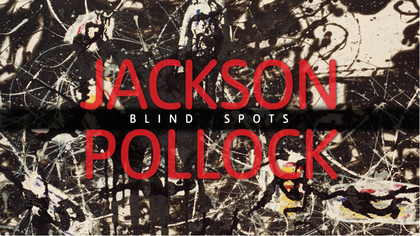Pollock the Sculptor
Acclaimed for the lyrical drip technique he pioneered, it might come as a surprise to learn that, at the beginning of his career, Jackson Pollock was set more on sculpture than painting. In a letter to family, dated 1933, Pollock said:
I am devoting all my time to sculpture now ‚Äď cutting in stone during the day and modelling at night ‚Äď it holds my interest deeply ‚Äď I like it better than painting ‚Äď drawing tho [sic] is the essence of¬†all.
Though a relatively slight aspect of his legacy, it was something Pollock would turn to in the hard times, when painting ‚Äď or life ‚Äď was proving difficult. A collaboration with his friend, the sculptor Tony Smith, would be the last creative endeavour he would undertake before his death in a car crash in¬†1956.
Pollock and Picasso
Jackson Pollock didn‚Äôt just happen across the techniques that led Life magazine to ask in 1949 ‚ÄėIs he the greatest living painter in the United States?‚Äô His journey had taken in various influences; from Mexican muralists such as Jos√© Clemente Orozco and Diego Rivera during the 1930s to the likes of European masters Wassily Kandinsky and Joan Mir√≥. But none of these looms quite so large as Picasso, whose impact can perhaps most strongly be seen in works such as Number 14 1951, in which monstrous reclining figures writhing in space seem to recall Picasso‚Äôs Guernica 1937; simultaneously, this is Pollock‚Äôs tribute and challenge to Picasso. Speaking to B. H. Friedman in 1969, his wife Lee Krasner Pollock had this to say about her husband‚Äôs relationship with the Spanish¬†artist:
‚Ķ there‚Äôs no question that he admired Picasso and at the same time competed with him, wanted to go past him‚Ķ I remember one time I heard something fall and then Jackson yelling, ‚ÄúGod damn it, that guy missed nothing!‚ÄĚ I went to see what had happened. Jackson was sitting, staring; and on the floor, where he had thrown it, was a book of Picasso‚Äôs¬†work‚Ķ
On Abstract Expressionism
The artistic movement that Pollock was most associated with, indeed in the vanguard of, was abstract expressionism. Best characterized by gestural mark-making, it calls to mind an artist channelling their unconscious directly onto canvas, or, as Pollock said: ‚ÄėThe modern artist ‚Ķ is working and expressing an inner world ‚Äď in other words expressing the energy, the motion, and other inner¬†forces.‚Äô
However, Pollock’s sense of what his art represented was never as clear cut as the assumptions of critics and commentators who sought so eagerly to categorise him. In a 1956 interview with the art historian Selden Rodman, he had this to say:
I don‚Äôt care for ‚Äúabstract expressionism‚ÄĚ ‚Ķ and it‚Äôs certainly not ‚Äúnon-objective,‚ÄĚ and not ‚Äúnonrepresentational‚ÄĚ either. I‚Äôm very representational some of the time, and a little all of the¬†time.
The Namuth Effect
Some of the most memorable images taken of Pollock, and perhaps of any artist at work, were those gleaned from photo shoots and filming sessions undertaken with the photographer Hans Namuth in 1950. Along with the Life magazine spread the previous year they were responsible in many ways for cementing Pollock’s reputation as a colossus of post-war American culture. But, it appears, as well as being iconic and career-defining, there would be other knock-on effects resulting from these sessions.
Pollock, who had had difficulties with alcohol from his mid-teens, had been undergoing regular therapy which saw him achieve two years of sobriety. Immediately following filming, he returned to drinking, leading some to suggest it was the exposure of performing on film that triggered this return to alcohol. Namuth, looking back on this time in 1979, wrote:
I have asked myself why Jackson chose this point in his life to resume drinking. In part, of course, it was the result of the circumstances of that last day of filming. There was a heavy air of crisis hanging about. […] One can, of course, speculate on the deeper reasons. I wasn’t aware of it at the time, but in retrospect I think he had reached a transition point in his work […].
Ī ī«ĪŰĪŰī«≥¶įžŐż≤—≤‚≥Ŕ≥ůī«ĪŰī«≤Ķ≤‚
The wider narrative of Pollock, one of the twentieth century‚Äôs most compelling figures, arises from a mixture of mythologies, truths and half-truths. David Elliott, in his essay ‚ÄėMyths‚Äô, (Jackson Pollock: Drawing into Painting 1979), notes ‚ÄėJackson Pollock‚Äôs mercurial career and early death in a car crash at the age of 44 are wholly in keeping with this pattern; his life and death as well as his work have both been absorbed into our cultural¬†history.‚Äô
There is also the idea that Pollock had been a na√Įve ‚Äėman-child‚Äô of an artist, haphazardly hurling paint at a canvas. But, as Helen A. Harrison, Director of the Pollock-Krasner House and Study Center has noted (biography.comŐż2015):
This is [a] misconception enshrined in the Pollock movie. For dramatic purposes, Pollock‚Äôs years of experimentation with liquid paint were condensed into a single ‚Äúeureka moment‚ÄĚ. He first tried it in 1936 ‚Ķ By 1947 he had perfected the technique of pouring, flinging and spattering liquid paint, and could control its flow to achieve the effects he was after.‚Äô Pollock modestly put the painstakingly accomplished method down to ‚Äė‚Ķ a natural growth out of a need‚Äô, explaining that: ‚ÄėI want to express my feelings rather than illustrate them. Technique is just a means of arriving at a¬†statement.

